The EU Eco-Management and Audit Scheme (EMAS)

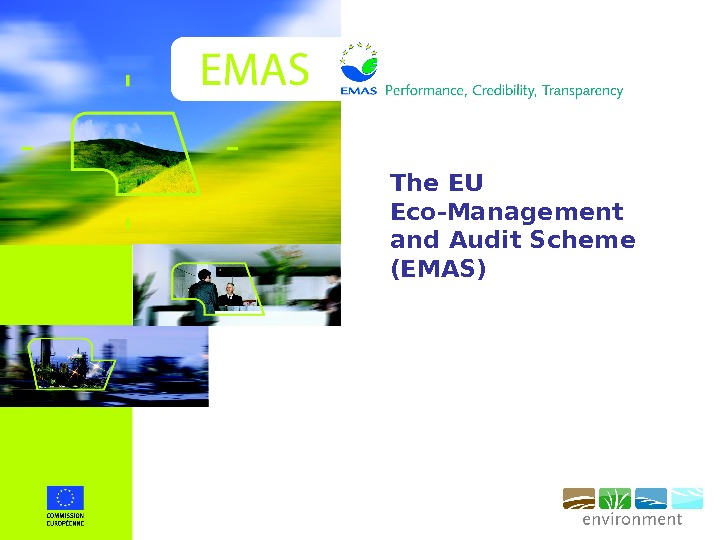







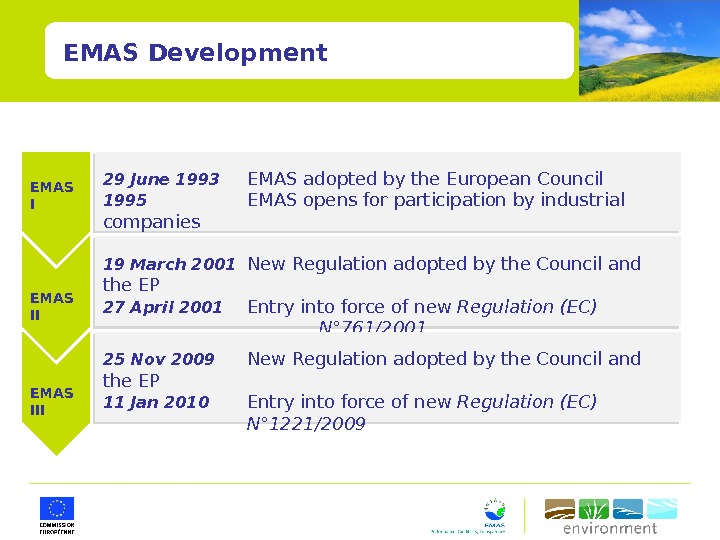

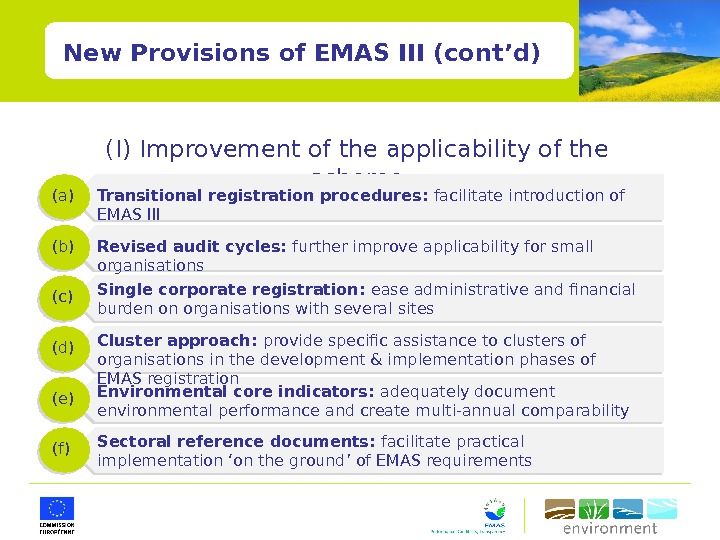



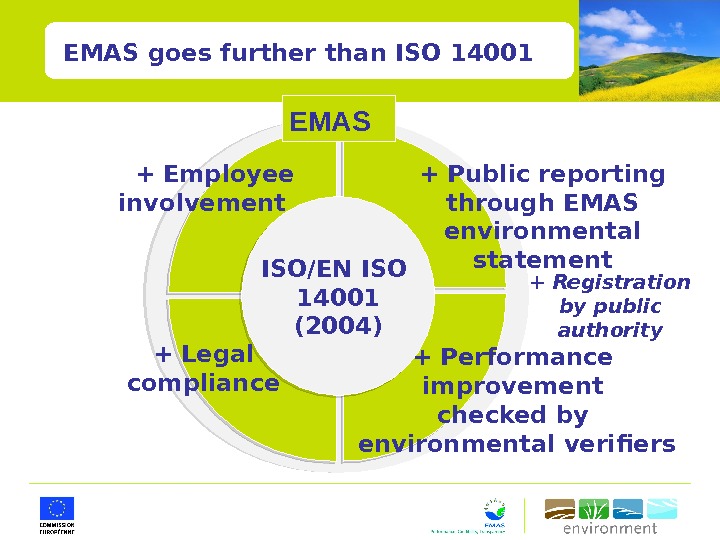




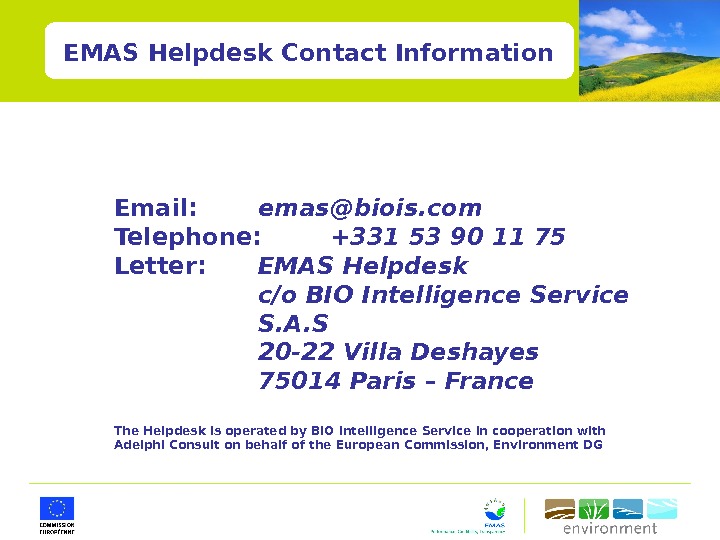
emas_general_presentation_2011.ppt
- Размер: 3.3 Mегабайта
- Количество слайдов: 20
Описание презентации The EU Eco-Management and Audit Scheme (EMAS) по слайдам
 The EU Eco-Management and Audit Scheme (EMAS)
The EU Eco-Management and Audit Scheme (EMAS)
 Voluntary environmental management tool operative since 1995 What is EMAS? Aim Continual improvements in the environmental performance of companies and other organisations Means Tools allowing organisations to measure, evaluate, report and improve environmental performance Outcomes Better management of environmental issues and credible information on these issues
Voluntary environmental management tool operative since 1995 What is EMAS? Aim Continual improvements in the environmental performance of companies and other organisations Means Tools allowing organisations to measure, evaluate, report and improve environmental performance Outcomes Better management of environmental issues and credible information on these issues
 EMAS follows a Systematic “Plan-Do-Check-Act” Approach
EMAS follows a Systematic “Plan-Do-Check-Act” Approach
 What are the Core Elements of EMAS? Performance Carrying out annual updates of environmental policy targets and actions to implement and evaluate these targets Credibility Third party verification by independent auditors guarantees the value of both actions taken and disclosed information Transparency Environmental statements provide public information about the environmental performance of the organisation EMAS Premium benchmark for environmental management
What are the Core Elements of EMAS? Performance Carrying out annual updates of environmental policy targets and actions to implement and evaluate these targets Credibility Third party verification by independent auditors guarantees the value of both actions taken and disclosed information Transparency Environmental statements provide public information about the environmental performance of the organisation EMAS Premium benchmark for environmental management
 Who can participate? I II Organisations operating in all economic sectors Organisations located inside or outside EU, EEA and Accession countries (EMAS Global)* * It is in the realm of EU Member States to allow registration of organisations located outside EU, EEA and Accession Countries. Before introducing EMAS Global a number of practical and legal issues need to be clarified.
Who can participate? I II Organisations operating in all economic sectors Organisations located inside or outside EU, EEA and Accession countries (EMAS Global)* * It is in the realm of EU Member States to allow registration of organisations located outside EU, EEA and Accession Countries. Before introducing EMAS Global a number of practical and legal issues need to be clarified.
 What are the Steps to EMAS Registration? Environmental review(1) Environmental policy Environmental management system Environmental audit Environmental statement Registration by Competent Body and use of EMAS logo(2) (4) (5) (6) (7) Environmental programme (3)
What are the Steps to EMAS Registration? Environmental review(1) Environmental policy Environmental management system Environmental audit Environmental statement Registration by Competent Body and use of EMAS logo(2) (4) (5) (6) (7) Environmental programme (3)
 What are Benefits of EMAS Registration? Risk minimisation: possibilities to reduce associated risk levels by assessing operational procedures(b) Regulatory compliance: greater awareness and knowledge of regulatory requirements Regulatory relief: regulators may choose to relax regulatory requirements Improved relations with internal stakeholders: employee involvement and training under EMAS can lead to improved employee morale Improved relations with external stakeholders: EMAS registration of a site in close proximity to residents can enhance credibility and transparency Competitive advantage: EMAS registration can lead to improved market access and increased market share(c) (d) (e) (f) (g) Cost reductions: better management of resources (e. g. energy and resources efficiency)(a)
What are Benefits of EMAS Registration? Risk minimisation: possibilities to reduce associated risk levels by assessing operational procedures(b) Regulatory compliance: greater awareness and knowledge of regulatory requirements Regulatory relief: regulators may choose to relax regulatory requirements Improved relations with internal stakeholders: employee involvement and training under EMAS can lead to improved employee morale Improved relations with external stakeholders: EMAS registration of a site in close proximity to residents can enhance credibility and transparency Competitive advantage: EMAS registration can lead to improved market access and increased market share(c) (d) (e) (f) (g) Cost reductions: better management of resources (e. g. energy and resources efficiency)(a)
 What are Costs of EMAS Registration? Fixed costs: assumed to be unrelated to staff numbers (e. g. registration fees, IT costs) External costs: incurred by employing external consultancy to support EMAS implementation (e. g. employee training) Internal costs: incurred by organisation staff to implement, administer and report on EMAS (e. g. internal audit)(a) (b) (c) Costs vary with the size and the sector of the organisation* * For detailed information about the costs of EMAS implementation and financial incentives, please contact your national Competent Body
What are Costs of EMAS Registration? Fixed costs: assumed to be unrelated to staff numbers (e. g. registration fees, IT costs) External costs: incurred by employing external consultancy to support EMAS implementation (e. g. employee training) Internal costs: incurred by organisation staff to implement, administer and report on EMAS (e. g. internal audit)(a) (b) (c) Costs vary with the size and the sector of the organisation* * For detailed information about the costs of EMAS implementation and financial incentives, please contact your national Competent Body
 EMAS Development EMAS III 29 June 1993 EMAS adopted by the European Council 1995 EMAS opens for participation by industrial companies 19 March 2001 New Regulation adopted by the Council and the EP 27 April 2001 Entry into force of new Regulation (EC) N° 761/2001 25 Nov 2009 New Regulation adopted by the Council and the EP 11 Jan 2010 Entry into force of new Regulation (EC) N° 1221/
EMAS Development EMAS III 29 June 1993 EMAS adopted by the European Council 1995 EMAS opens for participation by industrial companies 19 March 2001 New Regulation adopted by the Council and the EP 27 April 2001 Entry into force of new Regulation (EC) N° 761/2001 25 Nov 2009 New Regulation adopted by the Council and the EP 11 Jan 2010 Entry into force of new Regulation (EC) N° 1221/
 New Provisions of EMAS III Improvement of applicability of scheme Strengthening visibility and outreach of scheme
New Provisions of EMAS III Improvement of applicability of scheme Strengthening visibility and outreach of scheme
 New Provisions of EMAS III (cont’d) (I) Improvement of the applicability of the scheme Transitional registration procedures: facilitate introduction of EMAS III(a) Revised audit cycles: further improve applicability for small organisations Single corporate registration: ease administrative and financial burden on organisations with several sites Cluster approach: provide specific assistance to clusters of organisations in the development & implementation phases of EMAS registration Environmental core indicators: adequately document environmental performance and create multi-annual comparability Sectoral reference documents: facilitate practical implementation ‘on the ground’ of EMAS requirements(b) (c) (d) (e) (f)
New Provisions of EMAS III (cont’d) (I) Improvement of the applicability of the scheme Transitional registration procedures: facilitate introduction of EMAS III(a) Revised audit cycles: further improve applicability for small organisations Single corporate registration: ease administrative and financial burden on organisations with several sites Cluster approach: provide specific assistance to clusters of organisations in the development & implementation phases of EMAS registration Environmental core indicators: adequately document environmental performance and create multi-annual comparability Sectoral reference documents: facilitate practical implementation ‘on the ground’ of EMAS requirements(b) (c) (d) (e) (f)
 New Provisions of EMAS III (cont’d) (II) Strengthening EMAS visibility and outreach Single EMAS logo: communicate EMAS in one coherent and distinctive way(a) EMAS Global: encourage global uptake of the scheme by making EMAS certification possible for organisations outside the EU Community Information and promotion activities of EU Member States and European Commission: support uptake of EMAS III(b) (c) Recognition of other EMS: facilitate uptake from existing EMS to EMAS(c)
New Provisions of EMAS III (cont’d) (II) Strengthening EMAS visibility and outreach Single EMAS logo: communicate EMAS in one coherent and distinctive way(a) EMAS Global: encourage global uptake of the scheme by making EMAS certification possible for organisations outside the EU Community Information and promotion activities of EU Member States and European Commission: support uptake of EMAS III(b) (c) Recognition of other EMS: facilitate uptake from existing EMS to EMAS(c)
 In the Spotlight: Six Environmental Core Indicators Environmental key area Input/Impact Energy efficiency Total direct energy use: total annual energy consumption, expressed in MWh or GJ Total renewable energy use: percentage of total annual consumption of energy (electricity and heat) produced by the organisation from renewable energy sources Material efficiency Annual mass-flow of different materials used (excluding energy carriers and water): in tonnes Water Total annual water consumption: in m 3 Waste Total annual generation of waste: in tonnes Total annual generation of hazardous waste: in kilograms or tonnes Biodiversity Use of land: in m 2 of built-up area Emissions Total annual emission of greenhouse gases (incl. at least emissions of CO 2 , CH 4 , N 2 O, HFCs, PFCs and SF 6 ): in tonnes of CO 2 equivalent Total annual air emission (incl. at least emissions of SO 2 , NO x and PM): in kilograms or tonnes
In the Spotlight: Six Environmental Core Indicators Environmental key area Input/Impact Energy efficiency Total direct energy use: total annual energy consumption, expressed in MWh or GJ Total renewable energy use: percentage of total annual consumption of energy (electricity and heat) produced by the organisation from renewable energy sources Material efficiency Annual mass-flow of different materials used (excluding energy carriers and water): in tonnes Water Total annual water consumption: in m 3 Waste Total annual generation of waste: in tonnes Total annual generation of hazardous waste: in kilograms or tonnes Biodiversity Use of land: in m 2 of built-up area Emissions Total annual emission of greenhouse gases (incl. at least emissions of CO 2 , CH 4 , N 2 O, HFCs, PFCs and SF 6 ): in tonnes of CO 2 equivalent Total annual air emission (incl. at least emissions of SO 2 , NO x and PM): in kilograms or tonnes
 One single logo In the Spotlight: EMAS Logo
One single logo In the Spotlight: EMAS Logo
 EMAS goes further than ISO 14001 ISO/EN ISO 14001 (2004) + Public reporting through EMAS environmental statement + Legal compliance + Employee involvement + Performance improvement checked by environmental verifiers. EMAS + Registration by public authority
EMAS goes further than ISO 14001 ISO/EN ISO 14001 (2004) + Public reporting through EMAS environmental statement + Legal compliance + Employee involvement + Performance improvement checked by environmental verifiers. EMAS + Registration by public authority
 Successful EMAS Implementation: Involvement Stages Involved Parts Commitment Top Management Environmental review of activities Environmental manager, all departments What are our aims? Management How can we reach them? Management Is everything in line with EMAS? All employees, environmental managers, auditor(s) Statement of environmental performance Management, environmental managers External verification EMAS environmental verifier(s)
Successful EMAS Implementation: Involvement Stages Involved Parts Commitment Top Management Environmental review of activities Environmental manager, all departments What are our aims? Management How can we reach them? Management Is everything in line with EMAS? All employees, environmental managers, auditor(s) Statement of environmental performance Management, environmental managers External verification EMAS environmental verifier(s)
 EMAS Statistics
EMAS Statistics
 Further Information on the EMAS Website www. ec. europa. eu/environment/emas
Further Information on the EMAS Website www. ec. europa. eu/environment/emas
 Links • European Union: http: //www. europa. eu • EMAS Register: www. emas-register. eu • EMAS Toolkit for small organisations: www. ec. europa. eu/environment/emas/toolkit/ • EMAS Easy: http: //ec. europa. eu/environment/emas/tools/emaseasy_ en. htm • European Portal for SMEs: www. ec. europa. eu/enterprise/sme/ • EU Ecolabel: www. ec. europa. eu/environment/ecolabel/ • Green Public Procurement (GPP): www. ec. europa. eu/environment/gpp/index_en. htm • Environmental Compliance Assistance Programme for SMEs (ECAP): www. ec. europa. eu/environment/sme/index_en. htm • European Environment Agency: www. eea. europa. eu • International Standard Organisation (ISO): www. iso. org
Links • European Union: http: //www. europa. eu • EMAS Register: www. emas-register. eu • EMAS Toolkit for small organisations: www. ec. europa. eu/environment/emas/toolkit/ • EMAS Easy: http: //ec. europa. eu/environment/emas/tools/emaseasy_ en. htm • European Portal for SMEs: www. ec. europa. eu/enterprise/sme/ • EU Ecolabel: www. ec. europa. eu/environment/ecolabel/ • Green Public Procurement (GPP): www. ec. europa. eu/environment/gpp/index_en. htm • Environmental Compliance Assistance Programme for SMEs (ECAP): www. ec. europa. eu/environment/sme/index_en. htm • European Environment Agency: www. eea. europa. eu • International Standard Organisation (ISO): www. iso. org
 EMAS Helpdesk Contact Information Email: emas@biois. com Telephone: +331 53 90 11 75 Letter: EMAS Helpdesk c/o BIO Intelligence Service S. A. S 20 -22 Villa Deshayes 75014 Paris – France The Helpdesk is operated by BIO Intelligence Service in cooperation with Adelphi Consult on behalf of the European Commission, Environment DG
EMAS Helpdesk Contact Information Email: emas@biois. com Telephone: +331 53 90 11 75 Letter: EMAS Helpdesk c/o BIO Intelligence Service S. A. S 20 -22 Villa Deshayes 75014 Paris – France The Helpdesk is operated by BIO Intelligence Service in cooperation with Adelphi Consult on behalf of the European Commission, Environment DG

